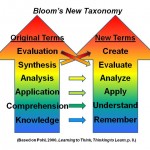Bloom’s Taxonomy – one step at a time
Spring is here, at last. In the Northeast, where I live, the flowers are finally in bloom. It makes me smile every time I drive down the block. So, it seems fitting to reintroduce Bloom’s Rose, a model for learning that was developed in 1956.
What does it mean for us today? It reminds us not to ask students application and analysis of new material until they’ve mastered the basics.
Each level of learning builds on a previous step. According to Blooms Taxonomy, cognitive learning follows this pattern*:
- Knowledge – the base of the pyramid requires learners to describe, identify, and recognize new learning concepts.
- Comprehension – illustrate, explain, interpret.
- Application – organize, generalize, apply.
- Analysis – compare, categorize, prioritize.
- Synthesis – combine, invent, create.
- Evaluation – critique, recommend.
 *A colleague just wrote to request that I update my example of Bloom’s Taxonomy. She said, “the revised taxonomy is in verb forms and recognizes ‘Create’ as the highest level.” I have to admit that as I was considering the model, I too thought that creating showed a higher level of understanding than critiquing it. Thank you Sue Ellen!
*A colleague just wrote to request that I update my example of Bloom’s Taxonomy. She said, “the revised taxonomy is in verb forms and recognizes ‘Create’ as the highest level.” I have to admit that as I was considering the model, I too thought that creating showed a higher level of understanding than critiquing it. Thank you Sue Ellen!

Bloom identified three domains of learning — cognitive (thoughts); affective (emotions); and psychomotor (physical movement)–each of which follows a fairly similar taxonomy.
And because I’m a strong believer in using mnemonics to remember things, try this: Kind, capable actor appreciates speedy employment.
————————————————————————————-
p.s. There has recently been an online discussion about the changes to Bloom’s Taxonomy. Patricia Harrold, CPLP, explained: “The model was updated in 2001 after a former student of Bloom’s, Lorin Anderson, put together a team to update it – targeting relevance primarily as well as accuracy in so far as how we achieve various levels of learning/competency. The team was made up of cognitive psychologists, curriculum theorists, instructional researchers, and testing and assessment specialists. It took over 5 years for the team to update the taxonomy to their satisfaction. Which when you compare and contrast the original to the revised… wow that’s a long time to make what appear on the surface as small changes. Yet, I believe they were significant to our understanding and utilization of the taxonomy.”
Here are some additional links that you might find useful:
- Comparison of old and new models: https://projects.coe.uga.edu/epltt/index.php?title=Bloom’s_Taxonomy
- A multi-dimensional revision of Blooms Taxonomy: https://www.celt.iastate.edu/teaching/RevisedBlooms1.html
- Reconceptualizing Teaching and Learning in a Technocracy (2001 model): https://education.ed.pacificu.edu/aacu/workshop/reconcept2B.html
- Exploration of Blooms Taxonomy used for critical and creative thinking: https://eduscapes.com/tap/topic69.htm
- Synopsis and background; https://edorigami.wikispaces.com/Bloom’s+Digital+Taxonomy

